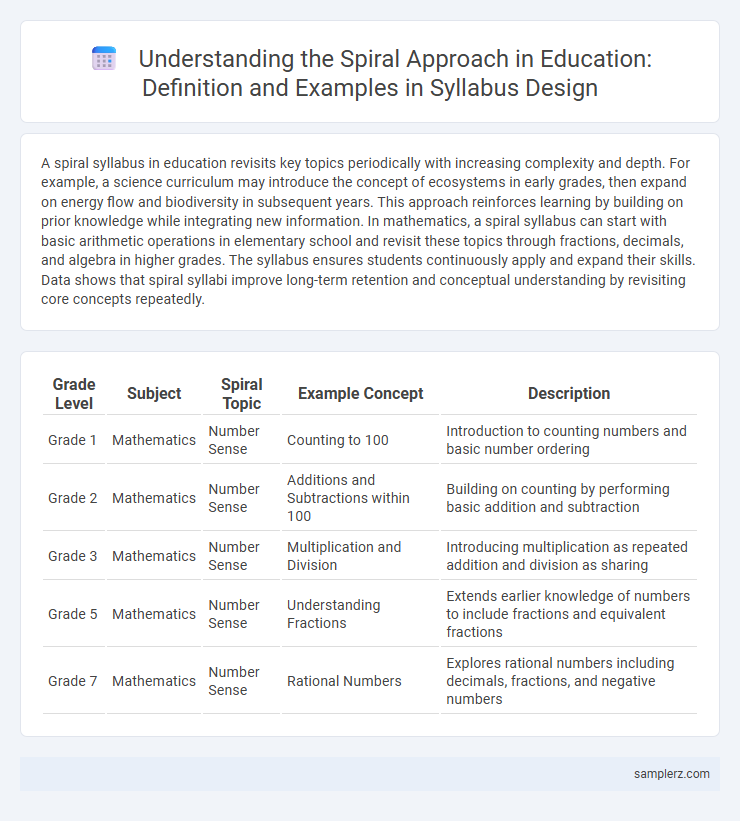A spiral syllabus in education revisits key topics periodically with increasing complexity and depth. For example, a science curriculum may introduce the concept of ecosystems in early grades, then expand on energy flow and biodiversity in subsequent years. This approach reinforces learning by building on prior knowledge while integrating new information. In mathematics, a spiral syllabus can start with basic arithmetic operations in elementary school and revisit these topics through fractions, decimals, and algebra in higher grades. The syllabus ensures students continuously apply and expand their skills. Data shows that spiral syllabi improve long-term retention and conceptual understanding by revisiting core concepts repeatedly.
Table of Comparison
| Grade Level | Subject | Spiral Topic | Example Concept | Description |
|---|---|---|---|---|
| Grade 1 | Mathematics | Number Sense | Counting to 100 | Introduction to counting numbers and basic number ordering |
| Grade 2 | Mathematics | Number Sense | Additions and Subtractions within 100 | Building on counting by performing basic addition and subtraction |
| Grade 3 | Mathematics | Number Sense | Multiplication and Division | Introducing multiplication as repeated addition and division as sharing |
| Grade 5 | Mathematics | Number Sense | Understanding Fractions | Extends earlier knowledge of numbers to include fractions and equivalent fractions |
| Grade 7 | Mathematics | Number Sense | Rational Numbers | Explores rational numbers including decimals, fractions, and negative numbers |
Understanding the Spiral Curriculum in Education
The spiral curriculum revisits key concepts at increasing levels of complexity, allowing learners to build deeper understanding over time. For example, in a mathematics syllabus, students might first learn basic addition in early grades and later encounter more complex operations like algebraic expressions that reinforce and expand on these foundational skills. This structured repetition enhances knowledge retention and supports cognitive development by connecting new information to prior learning.
Key Principles of Spiral Syllabus Design
Spiral syllabus design incorporates the principle of revisiting core concepts at increasing levels of complexity to reinforce and deepen student understanding over time. For example, a language course might introduce basic grammar rules in early units, then progressively expand on sentence structure and nuanced usage in later modules. This method leverages spaced repetition and scaffolded learning, ensuring knowledge retention and skill development aligned with cognitive growth.
Real-World Examples of Spiral Approaches in Math
Spiral syllabus in math often revisits key concepts such as fractions, geometry, and algebra across multiple grades, progressively increasing in complexity. For instance, primary students begin with basic fraction recognition, middle schoolers tackle fraction operations, and high schoolers apply fractions in real-world problems like financial calculations and probability. This spiral approach ensures continuous reinforcement and deeper understanding through real-world applications, enhancing student retention and problem-solving skills.
How Spiral Learning Enhances Science Education
Spiral learning in science education revisits key concepts such as cellular biology, chemical reactions, and Newtonian physics at increasing levels of complexity, reinforcing student understanding and retention. By integrating progressively challenging topics like advanced genetics or thermodynamics, it enables learners to build on prior knowledge systematically. This iterative approach fosters deeper comprehension and critical thinking skills essential for mastering complex scientific principles.
Spiral Syllabus in Language Arts: Practical Cases
Spiral syllabus in Language Arts revisits key concepts such as grammar, vocabulary, and literary analysis at increasing levels of complexity, enhancing retention and mastery. For example, students may first learn basic punctuation, then progressively encounter more complex sentence structures and stylistic devices in later units. This cyclical approach aligns with cognitive development theories, promoting deeper understanding and application of language skills over time.
Integrating Spiral Concepts in Social Studies
Integrating spiral concepts in social studies syllabus reinforces learning by revisiting key themes such as government, economics, and culture at increasing levels of complexity. This approach enables students to build on prior knowledge of historical events and civic principles while connecting them to contemporary societal issues. Revisiting and expanding topics like democracy and globalization enhances critical thinking and deepens understanding throughout the academic year.
Case Study: Spiral Curriculum Implementation in Primary Schools
Case Study: Spiral Curriculum Implementation in Primary Schools demonstrates how key concepts are revisited with increasing complexity to enhance student understanding. Topics like "Habitats" first introduce basic animal and plant environments, progressively advancing to ecosystem interrelationships and human impact in later grades. This method reinforces prior knowledge while accommodating cognitive development, leading to improved retention and application of scientific principles among primary students.
Assessing Learning Outcomes in Spiral Syllabi
In spiral syllabi, assessing learning outcomes involves revisiting key concepts at increasing levels of complexity to measure student progress effectively. Educators employ formative assessments such as quizzes, reflective journals, and practical projects aligned with each spiral iteration to gauge comprehension and skill development. This method ensures continuous reinforcement and deeper understanding, promoting mastery through iterative evaluation.
Challenges and Solutions in Spiral Curriculum Adoption
Challenges in adopting a spiral curriculum often include resistance from educators accustomed to traditional linear teaching methods and difficulties aligning assessments with iterative content revisits. Solutions involve comprehensive teacher training programs focused on the philosophy and implementation of spiral learning, along with developing adaptive assessment tools that measure student understanding across multiple stages. Incorporating technology-enhanced platforms can facilitate continuous content reinforcement and personalized learning pathways to overcome implementation barriers.
Best Practices for Designing a Spiral Syllabus
A well-designed spiral syllabus revisits core concepts such as critical thinking, scientific methodology, and mathematical problem-solving across multiple units, gradually increasing complexity to reinforce mastery. Best practices include clearly defined learning objectives for each cycle, formative assessments to gauge progress, and integration of interdisciplinary themes to promote deeper understanding. Consistent feedback loops and adaptive content pacing ensure that students build on prior knowledge effectively while staying engaged throughout the course.

example of spiral in syllabus Infographic
 samplerz.com
samplerz.com